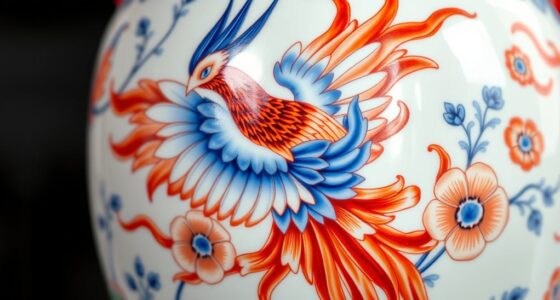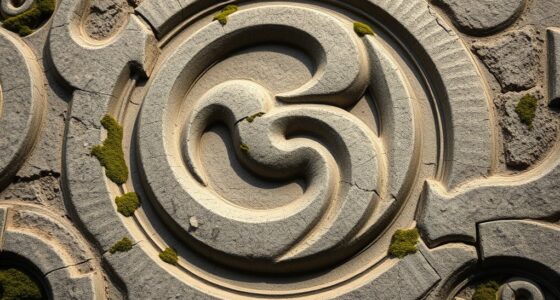An hourglass powerfully shows that time moves in one direction and can’t be reversed. As sand steadily slips from one chamber to another, you’re reminded of life’s fleeting moments and the unstoppable march of mortality. It encourages you to cherish each instant before it vanishes forever. This simple yet profound symbol urges you to live mindfully and appreciate the finite nature of life—if you stay curious, you’ll discover even more about how it speaks to our existence.
Key Takeaways
- The hourglass visually symbolizes the relentless, irreversible flow of time, emphasizing life’s fleeting nature.
- It serves as a metaphor for mortality, reminding us that moments are precious and cannot be retrieved once gone.
- Its physical movement contrasts with digital clocks, fostering a more personal awareness of time passing.
- The trickling grains encourage reflection on aging, decline, and the importance of living intentionally.
- Overall, the hourglass prompts mindfulness about mortality, urging us to cherish each moment before time runs out.

Have you ever wondered how an hourglass captures the passage of time? It’s a simple yet profound device that visually embodies the relentless flow of sand from one chamber to another. As the sand flows steadily, it offers a clear, tangible representation of our fleeting moments, making it a powerful symbol of temporal symbolism. You watch the grains fall, and in that steady descent, you’re reminded that time is moving forward—never pausing, never reversing. The steady stream of sand is more than just a measurement; it’s a metaphor for life’s impermanence, emphasizing that each moment is unique and irretrievable once gone.
An hourglass’s steady sand flow symbolizes life’s fleeting moments and our unstoppable march through time.
When you observe an hourglass, you’re witnessing a visual narrative that reflects life’s finite nature. The sand’s flow signifies the unalterable march of time, prompting you to think about how every second counts. Unlike digital clocks or calendars, an hourglass doesn’t display numbers or dates; instead, it shows the passage through physical movement. This tangible aspect of the sand’s movement makes the concept of time feel more immediate and personal. The grains are small, yet collectively they create an impression of constant change and inevitable progression. Their movement reminds you that mortality isn’t just a distant concept but an ongoing reality, pressing you to make the most of your limited moments.
The symbolism of the sand flow also speaks to the cycle of life and death. As the grains trickle down, they symbolize the inevitable decline that comes with aging and the transient nature of existence. The hourglass’s delicate balance prompts reflection on how you manage your time—whether you spend it wisely or let it slip away unnoticed. It’s a visual cue that life, like the sand, is fragile and can be lost in an instant. The hourglass, thus, becomes a poignant reminder to cherish each moment before it’s gone. It’s a powerful visual metaphor that emphasizes the importance of mindfulness, urging you to live intentionally in the limited time you have.
Furthermore, the hourglass can serve as a reminder of the importance of mindfulness, encouraging us to focus on the present and make the most of each fleeting moment. Ultimately, the hourglass teaches that time is both a relentless force and a precious gift. The steady sand flow encapsulates the passage of moments, while its symbolism underscores the importance of appreciating life’s fleeting nature. As you watch the grains fall, you’re confronted with your own mortality—reminded that time waits for no one, and each moment is an opportunity to live fully. The hourglass isn’t just about measuring time; it’s about understanding its significance, embracing the present, and acknowledging that, like the sand, our lives are finite.
Frequently Asked Questions
How Does the Hourglass Symbolize Life’s Fleeting Moments?
The hourglass symbolizes life’s fleeting moments through its sand symbolism, reminding you that time constantly slips away. Its shape captures the temporal significance of each passing second, encouraging you to cherish the present before it runs out. As the sand flows from one chamber to the other, it highlights the transient nature of life, urging you to make the most of every moment before time runs out.
What Cultural Differences Exist in Hourglass Symbolism?
You’ll notice that cultural differences shape how people interpret hourglass symbolism. In some cultures, hourglasses connect to patience and reflection during rituals, while others view them as symbols of life’s transient nature. Global interpretations vary, with some seeing them as reminders of mortality and time’s value. These diverse meanings reflect cultural values, emphasizing different aspects of time—whether as a fleeting moment, a cycle, or a sacred passage.
Can the Hourglass Be Used for Time Management Today?
You can definitely use the hourglass for modern productivity today. Its visual timers help you stay aware of time passing, encouraging focus and efficiency. Unlike digital timers, the hourglass provides a calming, tangible sense of progress, making it a great tool for managing tasks. Incorporating it into your routine can boost your awareness of time, helping you prioritize tasks and stay on track throughout your day.
What Is the History of Hourglass Design Evolution?
You’re curious about the evolution of hourglass design, which traces back to ancient timekeeping methods. Over centuries, artisans perfected glass craftsmanship, creating more precise and durable hourglasses. Early designs used simple glass bulbs connected by narrow necks, but later innovations added ornate frames and improved sealing. These improvements enhanced accuracy and aesthetics, making hourglasses both functional and decorative. Today, their design reflects a rich history rooted in ancient ingenuity and skilled craftsmanship.
Are There Any Scientific Studies Linking Hourglass Imagery to Perception of Mortality?
You might find that scientific studies show psychological associations between hourglass imagery and perceptions of mortality. Visual perception of an hourglass often triggers thoughts about the passage of time and life’s impermanence. When you see an hourglass, it can subconsciously remind you of limited time, influencing your awareness of mortality. These visual cues tap into deep-seated psychological associations, making hourglasses powerful symbols of life’s fleeting nature.
Conclusion
As the sand slips quietly through the hourglass, you realize it’s not just about measuring time—it’s a silent reminder of your fleeting moments. With each grain, time whispers secrets you can’t ignore, hinting at life’s fragile, unstoppable nature. So, as you watch the last grains fall, what will you do with the time left? The hourglass’s silent call leaves you on the edge, wondering what remains once the sands run out.











